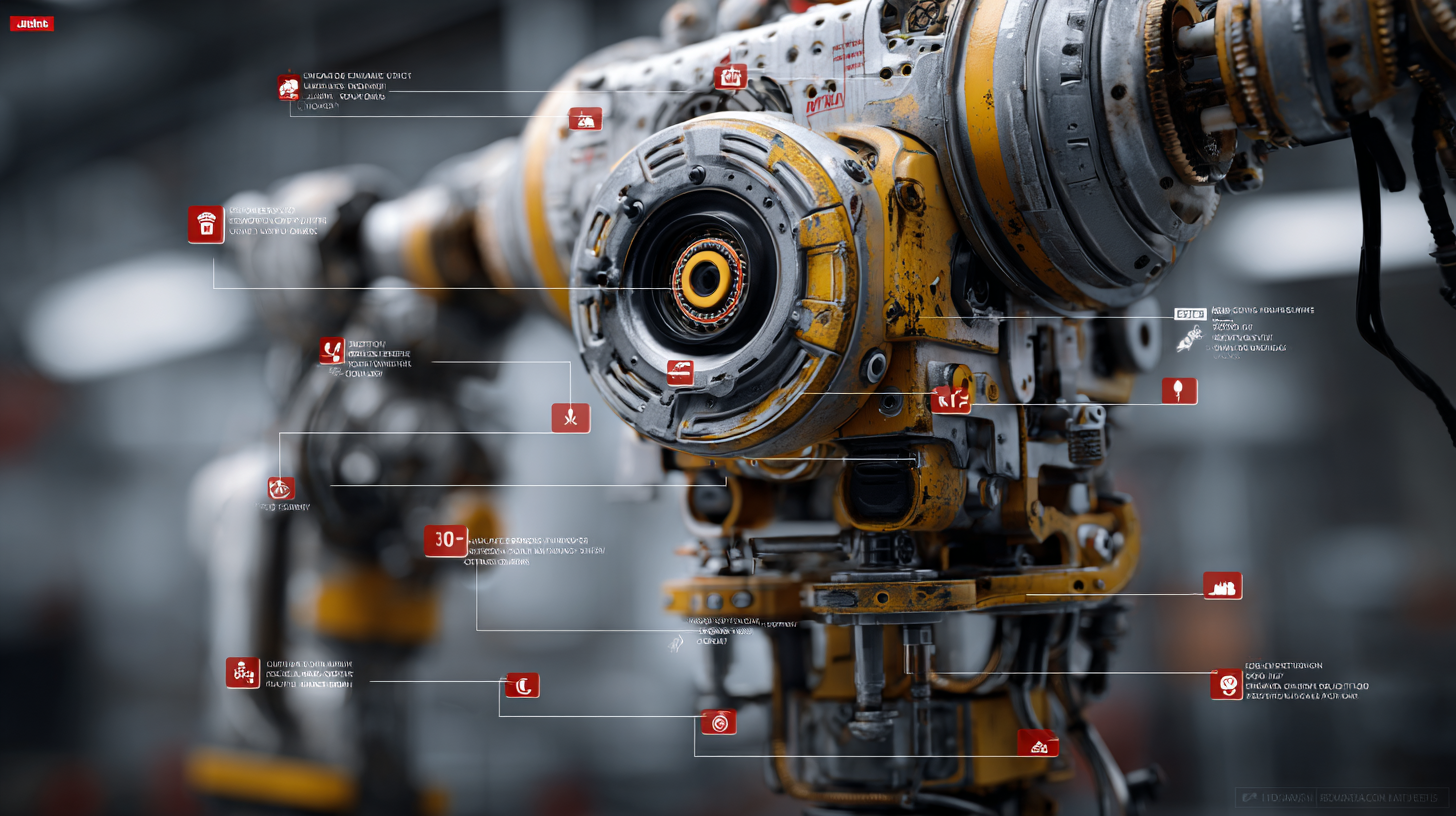A Comprehensive Guide to Sourcing the Best Robotic Parts for Your Projects
 In recent years, the demand for robotic parts has surged significantly, driven by advancements in automation and robotics across various industries. According to a report by Statista, the global robotics market is expected to reach approximately $500 billion by 2025, underscoring the critical role of high-quality robotic components in the development of innovative solutions.
China has emerged as a leading manufacturer of robotic parts, with its exports accounting for over 30% of global trade in this sector. This comprehensive guide will explore the essential factors to consider when sourcing robotic parts for your projects, emphasizing the importance of selecting suppliers that adhere to international standards and offer cutting-edge products.
By leveraging China's manufacturing prowess, engineers and developers can achieve greater efficiency and performance in their robotic applications, ultimately driving progress in automation technology.
In recent years, the demand for robotic parts has surged significantly, driven by advancements in automation and robotics across various industries. According to a report by Statista, the global robotics market is expected to reach approximately $500 billion by 2025, underscoring the critical role of high-quality robotic components in the development of innovative solutions.
China has emerged as a leading manufacturer of robotic parts, with its exports accounting for over 30% of global trade in this sector. This comprehensive guide will explore the essential factors to consider when sourcing robotic parts for your projects, emphasizing the importance of selecting suppliers that adhere to international standards and offer cutting-edge products.
By leveraging China's manufacturing prowess, engineers and developers can achieve greater efficiency and performance in their robotic applications, ultimately driving progress in automation technology.
Understanding the Global Impact of China's Robotics Manufacturing Industry
China's robotics manufacturing industry plays a pivotal role in shaping the global landscape of industrial robots. With the global market for industrial robots projected to exceed $20 billion by 2024, China is anticipated to capture about 40% of this market share. This significant presence is primarily driven by the increasing demand for automation across various sectors, particularly in applications such as welding, material handling, quality testing, and painting. Collaborative robots (cobots) specifically are gaining traction, with payload capacities ranging from 5 kg to over 11 kg, catering to diverse operational needs.
According to the ISO 8373-2021 standard, industrial robots are defined as automated, programmable machines that can be controlled on multiple axes, highlighting their versatility in manufacturing applications. As artificial intelligence continues to empower the manufacturing sector, China's focus on developing a new generation of AI technologies positions it as a formidable player in the global tech competition. This strategic emphasis on AI not only facilitates the optimization and upgrading of domestic industries but also enhances overall productivity, reflecting the transformative potential of China's robotics industry on a global scale.
Key Factors Influencing the Quality of Robotic Parts in China
When sourcing robotic parts, particularly from China, it’s crucial to consider several key factors that significantly influence the overall quality. The Chinese market is home to numerous manufacturers, with the International Federation of Robotics reporting that approximately 34% of global industrial robots were produced in China as of 2022. However, not all suppliers maintain stringent quality control standards, which can lead to variability in product performance.
 One primary factor is the level of certification and compliance with international quality standards. Many reputable manufacturers in China adhere to ISO 9001 certifications, ensuring a systematic approach to quality management. According to a report by MarketsandMarkets, the demand for high-quality robotic components has increased significantly, with the market expected to grow at a compound annual growth rate (CAGR) of 12% through 2026. Thus, potential buyers should prioritize suppliers with verifiable quality certifications to mitigate risks associated with substandard products.
One primary factor is the level of certification and compliance with international quality standards. Many reputable manufacturers in China adhere to ISO 9001 certifications, ensuring a systematic approach to quality management. According to a report by MarketsandMarkets, the demand for high-quality robotic components has increased significantly, with the market expected to grow at a compound annual growth rate (CAGR) of 12% through 2026. Thus, potential buyers should prioritize suppliers with verifiable quality certifications to mitigate risks associated with substandard products.
In addition, the use of advanced manufacturing technologies such as CNC machining and 3D printing can enhance the precision and durability of robotic parts. An industry analysis indicates that companies investing in these technologies often report a reduction of defects by up to 30%, thereby improving the reliability of their components. Thus, focusing on suppliers that employ such methodologies is vital for ensuring the quality and longevity of robotic parts in any project.
Evaluating Supplier Reliability: Data-Driven Approaches for Smart Sourcing
In the rapidly evolving landscape of supply chain management, evaluating supplier reliability through data-driven approaches has become paramount. With the advent of advanced analytics and machine learning, procurement professionals are now able to harness vast amounts of data to guide their sourcing decisions. According to recent studies, utilizing predictive analytics can improve demand forecasting accuracy by up to 25%, enabling organizations to optimize inventory levels and reduce costs. This not only enhances supplier relationships but also mitigates risks associated with volatile market conditions.
The integration of generative AI into sourcing and procurement operations is set to revolutionize the field further. By automating processes and enabling proactive risk management, generative AI allows procurement teams to make informed decisions faster. Reports indicate that businesses leveraging AI-driven tools can expect a reduction in procurement cycle time by approximately 30%. As the industry moves towards digital transformation, incorporating these innovative technologies will be crucial for organizations aiming to stay competitive and responsive in an increasingly complex supply chain environment.

Exploring Innovative Technologies in Robotic Components for Enhanced Projects
As the robotics industry continues to evolve, innovative technologies are emerging to enhance project outcomes significantly. In recent years, the global market for robotic components has witnessed rapid growth, expected to reach $80 billion by 2027, according to a report by ResearchAndMarkets. This surge is driven by advancements in artificial intelligence, machine learning, and sensor technologies, allowing developers to create more effective and efficient robotic systems.
When sourcing robotic parts, consider integrating components that leverage these emergent technologies. For instance, actuators and sensors designed with IoT capabilities can provide real-time data and analytics, greatly improving the responsiveness of your robotics applications. Additionally, utilizing modular robotic kits can facilitate rapid prototyping, enabling engineers to iterate their designs quickly based on real-world feedback.
**Tip:** Always check the compatibility of components before purchasing to avoid integration issues later on. Moreover, look for suppliers that offer detailed technical support and documentation, which can be invaluable for troubleshooting any challenges during your project development. Embracing these advanced components not only enhances performance but also keeps your projects at the forefront of the robotics landscape.
A Comprehensive Guide to Sourcing the Best Robotic Parts for Your Projects
| Component Type |
Description |
Material |
Weight (g) |
Price (USD) |
Applications |
| Servo Motor |
High precision and control for robotics |
Metal |
150 |
35 |
Robotic arms, drones |
| Microcontroller |
Central processing unit for robots |
Silicon |
10 |
15 |
All robotic applications |
| LiPo Battery |
Lightweight power source |
Lithium Polymer |
200 |
40 |
Drones, mobile robots |
| Robot Chassis |
Base structure for building robots |
Aluminum |
500 |
100 |
Mobile robots, educational kits |
| Camera Module |
Vision for navigation and processing |
Plastic, glass |
30 |
25 |
Surveillance, autonomous robots |
Budgeting for Robotic Parts: Cost Analysis and Comparison of Top Manufacturers
When budgeting for robotic parts, understanding the cost associated with different manufacturers is essential for maximizing your project's return on investment. The current landscape presents a variety of options, each with distinct pricing models that can significantly affect your overall budget. By conducting a thorough cost analysis, you can identify which manufacturers offer the best value for the components you need, enabling you to make informed decisions on where to allocate your resources.
Recent trends indicate that innovation in supply chain management and advanced technologies can lead to more efficient sourcing processes. Techniques such as machine learning and deep learning are enhancing how we evaluate suppliers and manage inventory, thereby optimizing costs over time. As companies emerge from economic uncertainties, those that integrate data-driven insights into their procurement strategies will be better positioned to navigate fluctuations in material costs and achieve competitive pricing for robotic parts. It's crucial to stay informed about industry innovations and shifts in pricing to remain agile in your sourcing decisions.
A Comprehensive Guide to Sourcing the Best Robotic Parts for Your Projects
This chart provides a cost analysis of various essential robotic parts. Understanding these average costs can help you budget effectively for your projects.


 In recent years, the demand for robotic parts has surged significantly, driven by advancements in automation and robotics across various industries. According to a report by Statista, the global robotics market is expected to reach approximately $500 billion by 2025, underscoring the critical role of high-quality robotic components in the development of innovative solutions.
China has emerged as a leading manufacturer of robotic parts, with its exports accounting for over 30% of global trade in this sector. This comprehensive guide will explore the essential factors to consider when sourcing robotic parts for your projects, emphasizing the importance of selecting suppliers that adhere to international standards and offer cutting-edge products.
By leveraging China's manufacturing prowess, engineers and developers can achieve greater efficiency and performance in their robotic applications, ultimately driving progress in automation technology.
In recent years, the demand for robotic parts has surged significantly, driven by advancements in automation and robotics across various industries. According to a report by Statista, the global robotics market is expected to reach approximately $500 billion by 2025, underscoring the critical role of high-quality robotic components in the development of innovative solutions.
China has emerged as a leading manufacturer of robotic parts, with its exports accounting for over 30% of global trade in this sector. This comprehensive guide will explore the essential factors to consider when sourcing robotic parts for your projects, emphasizing the importance of selecting suppliers that adhere to international standards and offer cutting-edge products.
By leveraging China's manufacturing prowess, engineers and developers can achieve greater efficiency and performance in their robotic applications, ultimately driving progress in automation technology.
 One primary factor is the level of
One primary factor is the level of 